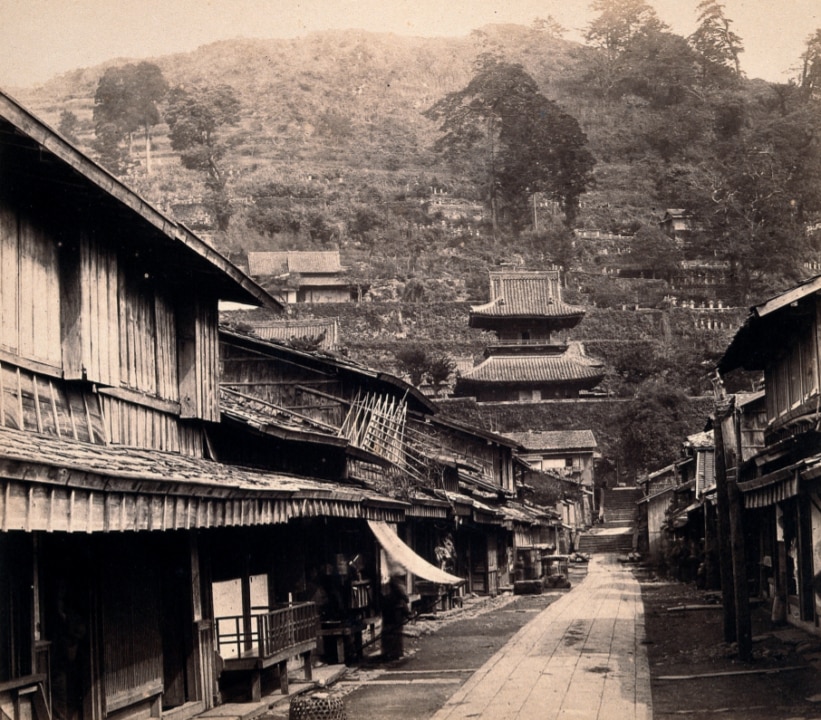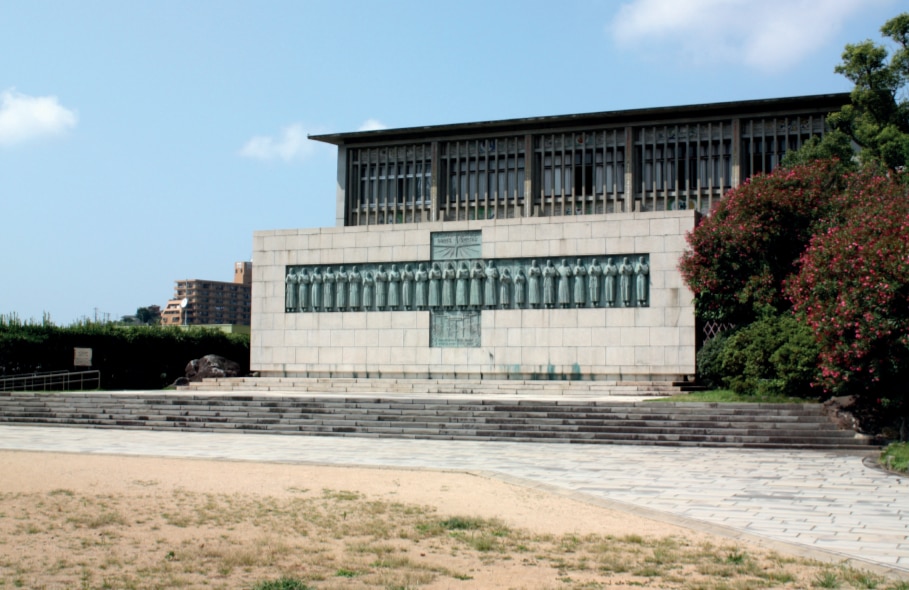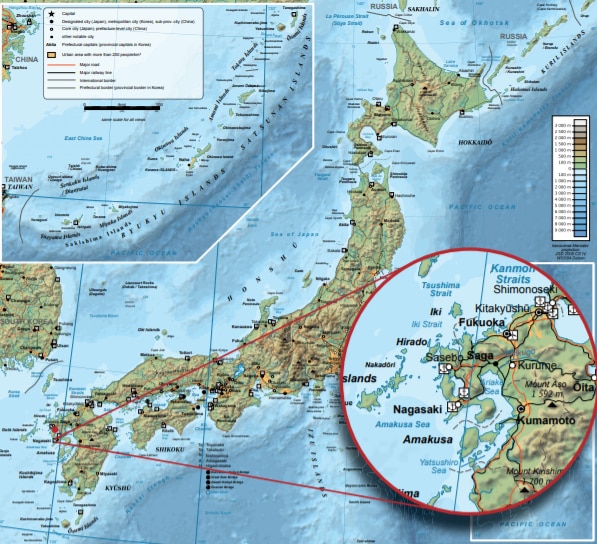Anees Ahmad Nadeem, Missionary-in-Charge, Japan
Two and a half centuries of persecution of the early Japanese converts to Christianity
In the history of religions, it is difficult to find a parallel to the horrific period of persecution that Christians had to endure in their first three centuries as a consequence of accepting Christianity and spreading their religion. The dark underground cemeteries in Rome – the catacombs of Rome – tell the story of the brutalities and religious persecution carried out against the early Christians.

The Romans made the lives of Christians – who believed in one God and considered Prophet Jesusas, son of Maryas, as their Redeemer – so difficult that it was impossible for them to survive and prosper on the surface of the earth.
Consequently, these sincere followers were forced to take refuge in underground caves to protect their faith. When the persecution would escalate, they would hide in secret underground caves with months of supplies. Sometimes, they had to spend years in this state.
The Holy Quran has referred to these sincere people as “Ashab al-Kahf” [people of the catacombs] and their sacrifices are mentioned in Surah al-Kahf. This period of persecution of the people of the catacombs lasted for more than three centuries. In the Holy Quran, Allah the Almighty says:
وَ لَبِثُوۡا فِيۡ كَهۡفِهِمۡ ثَلٰثَ مِائَةٍ سِنِيۡنَ وَ ازۡدَادُوۡا تِسۡعًا
“And they stayed in their Cave three hundred years, and added nine more.” (Surah al-Kahf, Ch.18: V.26)
This means that the said harsh period of oppression spanned over 309 years. Traces of more than 60 caves have been discovered in Rome that openly tell the story of the sacrifices of the early Christian missionaries and sincere followers of Christianity.
When the history of religious persecution is mentioned, the accounts of Nagasaki’s Christian missionaries and the harsh experiences of early Japanese converts to Christianity are a great lesson for every religion preaching in Japan. This long period of 200 years of cruelties consists of countless incidents of painful atrocities, torture, imprisonment, exile and sacrifices of lives.
Nagasaki is a historic city in the far south of Japan. Until the 16th century, all Japanese ports, including Nagasaki’s port, were a means of trade and communication with the outside world. However, in the 17th century, in view of the growing dangers of Western colonialism, the Japanese government adopted a self-imposed policy of isolation from the world. As a consequence, from 1641 to 1858, the entry of a foreigner into Japan became a mere dream and a fantasy. This period is known as the period of national isolation.
In this period of national isolation and dissociation policy, when there would arise a need for contact with a foreign state, the port of Nagasaki was the only means of communication.
This period of national isolation and self-imposed dissociation of the Japanese government was an out-of-the-ordinary time in the history of Japan. Even the emperors of Japan had become a mere showpiece to the power of regional chiefs and feudal lords.
In this age of mutual disputes and conflicts between regional chiefs, influential leaders and rulers began to see European merchants and missionaries as a threat to their power. Portuguese and German merchants had established trade links with Japan through various islands in the Pacific.
Arrival of the first priest in Japan as a representative of the king of Spain and Portugal
A few years prior to the implementation of the national isolation policy, a famous Christian priest, Francis Xavier – who was known for preaching Christianity in India, China and other Eastern countries – arrived in Kagoshima, a suburb of Nagasaki, in 1549. Coming to Japan as a missionary of Christianity was not free from danger, so he arrived in Japan from the Indian state of Goa as a representative of the King of Spain and Portugal, Philip II.
Francis Xavier began his mission on the outskirts of Nagasaki. His efforts paid off very soon and a local feudal lord converted to Christianity and joined Francis Xavier. The feudal class associated with trade also began to feel a mercantile interest in extending friendly relations with the Western world. As a result, a large number of people, including influential people, began to convert to Christianity. Coincidentally, in those days the government was of Oda Nobunaga in Japan who, due to personal prejudice against Buddhism, proved somewhat lenient towards Christianity.
Rome of Japan – the city of Nagasaki
Christian priests began to spread the message of Christianity by pursuing the feudal lords of Nagasaki city and its environs. Some scholars are of the view that instead of attraction in the message of Christianity, the said people had cast their glances on mercantile interests and relations with the Western world.
Whatever the reasons may be, the fact is that the city of Nagasaki soon became a centre for Christianity. As a result of the landlords’ conversion to Christianity, the lower classes and peasant families, who were under their influence, also began to convert to Christianity.
According to researchers, after a few years of hard work, the number of Japanese converts to Christianity was not in thousands but in millions. Consequently, the city of Nagasaki became known as the “Rome” of Japan. The Christian population in and around Nagasaki in the early 17th century is estimated at 500,000. (www.bbc.com/news/world-asia-50414472)
Beginning of cruelties on the Christians of Nagasaki
This was a time when Japan’s centuries-old monarchial system was on the decline. The government’s administration was in the hands of powerful chiefs and the presence of an emperor was merely symbolic.
After the death of the ruler, Oda Nobunaga, who had a soft-corner for Christianity, the reign of Toyotomi Hideyoshi and Tokugawa Ieyasu started in Japan. These two periods marked the beginning of suffering and persecution for early Japanese converts to Christianity that spanned over and above the next two centuries.
In this period of political instability, when a large number of people, including local chiefs and influential figures, converted to Christianity in 1587, Toyotomi Hideyoshi issued two anti-Christian ordinances to stop the progress of priests and ordered the exile of Christian clergy. As a result of converting to Christianity, penalties and punishments were announced for wealthy people, government officials and influential people. Moreover, it was considered a crime to renounce Buddhism or the Shinto religion and convert to Christianity.
The scope of their lives was narrowed down to the extent that the early Japanese Christians had only two options: either to renounce Christianity and return to their previous religion, or embrace death to protect their faith.
On January 1597, 26 people, including six priests, were arrested. To make an example out of them, along with physical and mental torture, they were dragged in various towns and cities of Japan and brought to the stronghold of Christianity, Nagasaki. They were then crucified on 5 February 1597 in the middle of the city.
A glimpse of the said brutality and a description of the events that unfolded with those 26 Christians who sacrificed their lives that day can be read in the novel, Kirish’tan: Heaven’s Samurai: A novel of old Japan. Those who sacrificed their lives are remembered in history as “The Twenty-Six Martyrs of Japan”.
A church in Nagasaki is named in memory of those who sacrificed their lives and it has now been declared as Japan’s national heritage. Apart from the famous Hollywood movie, Silence, several books and research papers uncover the truths of the events which show the determination and perseverance of the Christians of Nagasaki.

The practice of blasphemy against Jesusas to prove dissociation with Christianity
The 17th century dawned upon the early Japanese Christians as one of the worst centuries with respect to suffering and cruelties.
In 1612, new laws were introduced, declaring the preaching of Christianity a crime and ordering the demolition of the Christian cathedrals. Despite the implementation of anti-Christian laws, public crucifixion and persecution of priests and active Christians, the majority of those who converted to Christianity remained steadfast on their faith.
Thus, in order to uproot Christianity, rather than persecuting the affluent, the authorities decided to target the common Christian folk. Consequently, it was decided about the city of Nagasaki, which was called the “Rome of Japan” and had a population of millions, to give all its inhabitants one last chance to prove their detachment from Christianity.
However, it was a difficult task to find out who was a follower of which religion in a population of millions. Many suggestions came under consideration, but in view of the possibility that a person may verbally deny Christianity under pressure but their heartfelt commitment may remain with their faith, it was decided to force the Christian inhabitants of Nagasaki to do blasphemy against Prophet Jesusas and Maryas in order to prove their dissociation with Christianity. Hence, images of these holy personalities were made on brass or wooden boards and the inhabitants of the city were ordered to trample on them with their feet in order to prove that their hearts had repented from Christianity.
According to the researchers, the act of trampling on the image of Christ, i.e. Fumie, become an annual routine. The Christians, especially Catholics, give special importance to the image of Christ and Mary, so anyone about whom it was thought that they had converted to Christianity, was compelled to stomp on the image of Christ and Mary to show their detachment from Christianity. (The Triumph of Perseverance: Kakure Kirishitan in Japan and its Inscription on the World Heritage List by Joanes da Silva Rocha [2018], p. 168)
According to a BBC research report:
“Around the 1620s, authorities decided it wasn’t enough to get rid of the religious leaders. They had to come up with a public way to root out the religion from the hearts of the people. The solution? The fumie. These were brass images, sometimes set in wooden boards, depicting either Christ or Mary. Every single person that lived in Nagasaki was ordered to go through the practice of stepping on the fumie. Soon it became an annual practice carried out at the start of each year.” (www.bbc.com/news/world-asia-50414472)
In Japanese, the term “fumie” is used to refer to the said practice of trampling the image of Jesusas underfoot.
According to the BBC report, Martin Ramos, Professor of Japanese studies at the Ecole Francaise D’extreme-Orient, said:
“It was an obligation, the commoners, the samurai, the Buddhist monks, even sick people couldn’t miss it – they would bring the wooden board to their house. Every single person had to do this.” (Ibid)
The BBC also quoted Professor Simon Hull, an expert in Japanese Catholicism at Nagasaki Junshin Catholic University, as follows:
“If you examine an original fumie closely, one poignant detail is that the face of Christ has been completely worn away, [reminding] us of the countless feet that would have trampled on it.” (Ibid)
The BBC report further states:
“The Christians who refused to tread on the fumie were killed, or, more commonly, tortured.” (Ibid)

The city of Nagasaki still has numerous monuments and museums that tell the tale of the resoluteness and determination of the “Hidden Christians” of Japan and their steadfastness on the religion. A memorial wall having the names and statues of the first 26 people who sacrificed their lives owing to their religion has been erected on Nagasaki Hill. A glimpse of the persecution of Christians can be observed in the museums of Nagasaki. The images carved on the statues and boards that were trampled underfoot were almost identical to the image of Gautama Buddha. These statues of Prophet Jesusas and Maryas portray a dark picture of the 200 years of atrocities faced by the early Japanese Christians.
The severity of the said catastrophes can somewhat be estimated from the following incident:
On 7 October 1613, eight Christians were burned to death on the island of Kyushu. When the governor of Nagasaki ordered to burn those eight Christians alive, the three Japanese Samurai on duty refused to obey his orders. Consequently, all three of them were killed along with their families. (Full sail with the wind of grace-Peter Kibe and 187 martyrs [2008], pp. 51-52)
Some researchers consider that the acts of blasphemy of the early Japanese Christians, which they carried out against Christ and Mary to keep their religion from annihilating in Japan, was a sign of their weakness of faith. However, it is also a fact that hundreds of Nagasaki residents accepted death over the blasphemy of Prophet Jesusas, and there were thousands of Christians who could not cope with the sufferings and succumbed to those atrocities. Consequently, they went through that apparent act of blaspheming Christ and Mary against their will and kept Christianity hidden and safe in their hearts and waited for better times. According to the BBC, Professor Simon Hull said:
“One of the paradoxes of Japanese Christian history is that if all Japanese Catholics had refused to trample on the fumie and instead chosen to die as martyrs, Christianity in Japan would also have died. It is only because some made an existential decision to trample on the fumie, despite their belief that this action was gravely sinful, that Christianity in Japan was able to survive.” (www.bbc.com/news/world-asia-50414472)
(Translated by M Adam Ahmad, Al Hakam)

